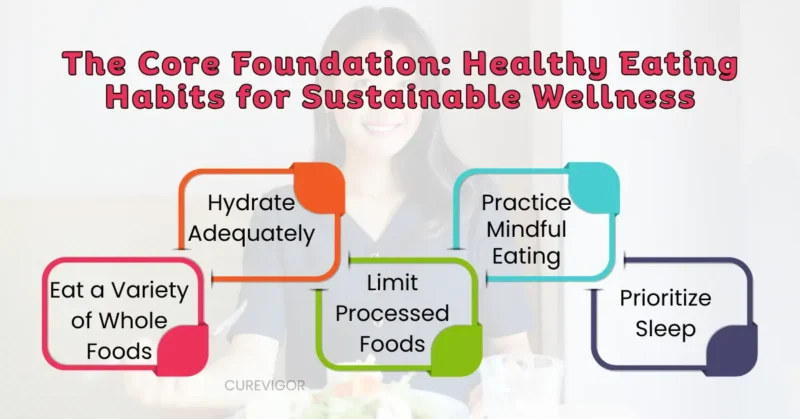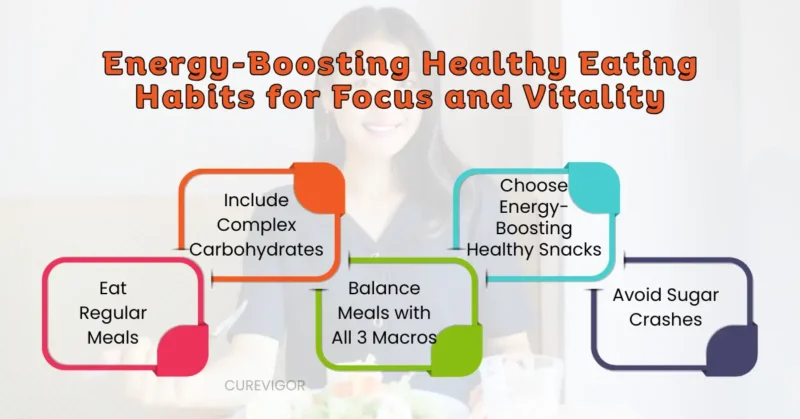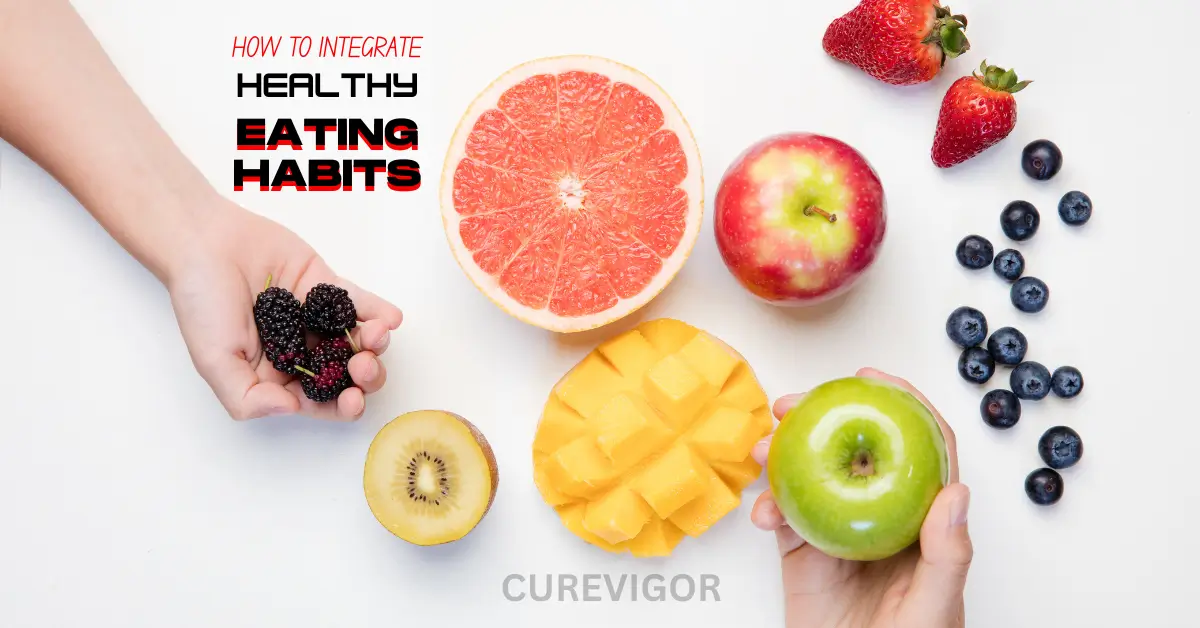Master 30 proven healthy eating habits to boost metabolism, improve digestion, and sustain energy all day long.
Thank you for reading this post, don't forget to subscribe!Eating a balanced diet isn’t just about weight — it’s essential for maintaining strong overall health, boosting consistent energy levels, and supporting cognitive well-being. With numerous conflicting nutrition recommendations available, it’s essential to be discerning about what to believe.
30 Science-Backed Healthy Eating Habits to Elevate Your Diet and Energy
To cut through the noise, we’ve broken down 30 science-backed healthy eating habits into four actionable categories. Incorporating these proven strategies will help you elevate your diet and energy for a healthier and more sustainable lifestyle.
Whether you’re feeling sluggish midday, struggling with cravings, or just want a more vibrant, stable sense of vitality, adopting these habits can make a real difference. Let’s dive into the core foundations first — because all long-term nutrition success starts with base habits.
The Core Foundation: Habits for Sustainable Wellness

These foundational habits are the non-negotiables that create a strong base for all other nutrition goals.
1. Eat a Variety of Whole Foods
Think of your dish as a rainbow of flavors, textures, and colors, including deep purples, earthy browns, bright oranges, and crisp greens. This is what a variety of whole foods looks like in action.
These foods — fruits, vegetables, whole grains, lean proteins, and healthy fats — come as close to their natural form as possible, without the additives and preservatives that often hide in processed alternatives.
Packed with vitamins, minerals, antioxidants, and fiber, whole foods are nutrient powerhouses that your body can identify and effectively employ for protection, repair, and vitality.
According to studies, eating a wide range of whole foods lowers the risk of developing chronic conditions like diabetes, heart disease, and even some types of cancer.
But variety is the secret weapon here. Each ingredient brings something different to the table, and rotating your choices helps expose your body (and your gut microbiome) to a broader spectrum of nutrients, improving digestion, immunity, and mood regulation.
So instead of eating the same salad every day, experiment: swap spinach for arugula, quinoa for farro, or lentils for chickpeas.
2. Hydrate Adequately
Water is life — quite literally. Yet it’s often the most overlooked element of healthy eating habits. You can lose energy, think erratically, slow down your digestion, and fool your brain into believing you’re hungry when you’re truly thirsty if you’re even slightly dehydrated.
Every cell, tissue, and organ in your body depends on water to function optimally. It transports nutrients, regulates body temperature, cushions joints, and even aids in fat metabolism. According to nutrition experts, hydration also directly affects mood and focus — a 1–2% drop in hydration can impair cognitive performance and reduce alertness.
Here’s a simple rule: if your urine is pale yellow or clear, you’re likely well-hydrated. Instead of drinking a lot of water at once, try to sip it frequently throughout the day. Carry a reusable bottle, add slices of cucumber or lemon for flavor, or enjoy herbal teas and water-rich foods like watermelon and cucumbers.
3. Limit Processed Foods
Think about what happens when food is “processed”: it’s stripped, altered, and often loaded with ingredients your body doesn’t recognize — refined sugars, trans fats, artificial flavors, and excessive sodium. These drugs have the potential to deplete your energy, disrupt your hormone balance, and aggravate your system over time.
Ultra-processed foods (UPFs) — think chips, sugary cereals, frozen dinners, sodas, and packaged snacks — make up more than half of the average diet in many developed countries. Research links higher UPF consumption with increased risk of obesity, heart disease, and metabolic disorders.
By contrast, whole and minimally processed foods support steady blood sugar, clearer skin, sharper focus, and a healthier weight. Making the switch doesn’t have to be dramatic. Start small: replace white rice with brown or wild rice, or choose fresh or frozen fruit instead of juice or candy. Remember: food should come from nature, not a factory.
4. Practice Mindful Eating
Mindful eating is one of the most transformative healthy eating habits you can cultivate — and it doesn’t require counting calories or following rigid rules. Instead, it’s about being fully present with your food: slowing down, noticing the aromas, textures, and flavors, and truly savoring every bite.
In a fast-paced world of multitasking and eating on the go, it’s easy to lose touch with the sensory joy of eating. Practicing mindfulness at meals helps regulate hunger cues, prevent overeating, and improve digestion by allowing your body’s “rest and digest” system to activate.
Try this: put your fork down between bites, chew your food completely, and switch off screens as you eat. Your relationship with food can be completely changed by making these small changes. Over time, you’ll find yourself eating less but feeling more satisfied — because you’re finally listening to your body instead of rushing through your meal.
5. Prioritize Sleep
Sleep and nutrition are two sides of the same wellness coin — and neglecting one throws the other out of balance. You wake up desiring sugary, high-carb foods for instant energy because your body creates more ghrelin, the hunger hormone, and less leptin, the fullness hormone, when you don’t get enough sleep.
Research confirms that chronic sleep deprivation can lead to increased calorie intake, impaired glucose metabolism, and a greater risk of obesity and heart disease. No matter how perfect your diet is, without enough rest, your body can’t process nutrients or regulate appetite effectively.
Try to get between 7 and 9 hours of good sleep each night. Establish a soothing bedtime routine and try to go to bed and wake up at the same time daily to support your body’s natural circadian rhythm. When your sleep is optimized, your metabolism, digestion, and mood follow suit.
Energy-Boosting Healthy Eating Habits for Focus and Vitality

Your diet must work like a well-tuned engine, fed continuously rather than intermittently, if you want to remain alert, focused, and energized throughout the day. Use these techniques to maintain optimal brain and body function.
6. Eat Regular Meals
Think of your metabolism like a campfire — it burns brightest when it’s fed with steady, balanced fuel. Skipping meals causes blood sugar drops, leading to fatigue and poor concentration.
Eating regular, structured meals helps maintain stable glucose levels, reducing irritability and overeating later. A balanced approach looks different for everyone, but consistency is key to regulating hormones and digestion.
7. Include Complex Carbohydrates
Complex carbohydrates — like oats, quinoa, brown rice, beans, and sweet potatoes — are your body’s preferred source of long-lasting energy.
Unlike refined carbs, which cause quick spikes and crashes, complex carbs digest slowly, offering a steady release of glucose to fuel your brain and muscles. Swap white rice for quinoa or bulgur, and start your morning with steel-cut oats.
8. Balance Meals with All Three Macros
Every meal should have a combination of complex carbohydrates, healthy fats, and protein for the best possible energy and satiety. This trio stabilizes blood sugar, prolongs feelings of fullness, and slows down digestion.
The combination of quinoa salad with mixed veggies, grilled chicken breast, and a drizzle of olive oil is a well-balanced example.
9. Choose Energy-Boosting Healthy Snacks
The right healthy snacks can prevent extreme hunger, stabilize blood sugar, and enhance focus between meals. Opt for snacks that combine protein, fiber, and healthy fats, such as a handful of almonds or walnuts with a piece of fruit, or Greek yogurt with cinnamon and chia seeds.
Prepare snacks in advance to reduce the temptation for ultra-processed alternatives.
10. Avoid Sugar Crashes
Refined sugars cause rapid blood glucose spikes, followed by an unmistakable crash that leaves you tired, moody, and craving more. Check ingredient labels for hidden sugars (like “corn syrup” or “maltose”) in drinks and condiments.
Pair any sweet treat with protein or fat (e.g., dark chocolate with almonds) to slow sugar absorption and maintain smoother energy throughout the day.
Healthy Eating Habits for Sustainable Weight Management and Satiety
Sustainable weight management involves developing consistent habits that nourish your body and keep you satisfied, focusing on satiety and hormonal balance.

11. Eat More Protein
If there’s one nutrient that deserves the spotlight in weight management, it’s protein. It’s the satiety superstar that regulates appetite hormones and preserves lean muscle mass. Include protein-rich foods—like eggs, fish, tofu, or legumes—at every meal to stay full longer and reduce cravings.
12. Incorporate Healthy Fats
Hormone balance, cognitive function, and nutrient absorption all depend on healthy fats. Focus on unsaturated fats from avocado, nuts, olive oil, and fatty fish. Use them to replace processed oils and keep your meals both satisfying and nourishing.
13. Load Up on High-Volume Foods
High-volume, low-calorie foods—like leafy greens, soups, and salads—fill your stomach with fewer calories. Their water and fiber content curb overeating. Start meals with vegetables or broth-based dishes to feel full faster.
14. Watch Portion Sizes
If portions are excessively big, even nutritious foods might add up to too many calories. Use smaller plates, wait 20 minutes before seconds, and visualize proper serving sizes (protein = palm size). Minor adjustments lead to significant results.
15. Cook at Home More Often
Home cooking gives you control over ingredients, portions, and quality. Research shows it reduces calorie and sodium intake. Batch-cook grains, proteins, and veggies so nutritious meals are always within reach.
Habits for Gut Health, Longevity, and Disease Prevention
These healthy eating habits support long-term disease prevention, anti-inflammation, and a thriving internal ecosystem.
16. Eat More Fiber
Fiber keeps digestion smooth, stabilizes blood sugar, and nourishes your gut microbiome. Aim for 25–35 grams daily from fruits, vegetables, oats, legumes, and seeds. Think “plants first” at every meal.
17. Choose Whole Grains
Refined grains lack the B vitamins, antioxidants, and fiber that whole grains like barley, quinoa, and brown rice offer. Frequent consumption reduces the risk of diabetes and promotes heart health.
18. Limit Added Sugars
Too much sugar spikes blood glucose and drives inflammation. Check labels—added sugars hide in sauces, dressings, and drinks. Keep intake below 10% of total daily calories.
19. Include Fermented Foods (Probiotics)
Fermented foods—like yogurt, kefir, and kimchi—feed beneficial gut bacteria and support immunity. Include a small serving daily for a healthier, more resilient gut.
20. Add Prebiotic Foods
Prebiotics (the food for probiotics) come from garlic, onions, bananas, and oats. Pair them with probiotics for a double dose of gut nourishment.
21. Eat the Rainbow
Each color of plant food represents unique antioxidants and phytonutrients. Aim for five or more colors daily to boost cellular defense and disease prevention.
22. Season with Herbs and Spices
Spices like turmeric, ginger, and cinnamon deliver anti-inflammatory and antioxidant benefits. Use them freely to enhance flavor without added salt or sugar.
23. Minimize Salt Intake
Excess sodium raises blood pressure. Limit processed foods, taste before salting, and season meals with herbs, lemon, or vinegar for zest instead of salt.
24. Limit Inflammatory Oils
Reduce intake of processed seed oils (soybean, corn) and replace with omega-3-rich sources—flaxseed, walnuts, and olive oil—to support heart and brain health.
25. Read Nutrition Labels
Labels reveal hidden sugars, unhealthy fats, and sodium. Scan ingredient lists for simplicity—if you can’t pronounce it, it’s likely not real food.
26. Plan Your Meals
Meal planning prevents impulsive eating and supports consistency. Spend 30 minutes weekly organizing meals and prepping ingredients for easy weekday choices.
27. Make Breakfast Non-Negotiable
Your metabolism is set for the day by a well-balanced breakfast high in fiber and protein. Consider whole-grain bread with eggs or Greek yogurt and berries.
28. Practice the ‘Plate Method’
Visualize your plate: half vegetables, one-quarter protein, one-quarter complex carbs. This balanced ratio simplifies healthy eating without tracking calories.
29. Eat Slower and Chew Thoroughly
Chewing well improves digestion and helps your brain register fullness. Put down your fork between bites and savor the flavors—it’s mindful eating in action.
30. Prepare for Cravings
Keep nourishing snacks—nuts, fruit, boiled eggs—on hand for when hunger hits. Cravings often fade when you’re hydrated, rested, and well-fed.
Integrating the Habits: Where to Begin & How to Sustain
Start Small and Layer
Implementing all 30 habits at once is overwhelming. Instead, pick two or three foundational habits (e.g., hydrate adequately, eat more fiber, limit processed foods) and focus on consistency for one week before layering more. Over time, these become automatic.
Use Nudges and Environment
You can “nudge” yourself into better behavior by shaping your environment: keep water bottles within reach, pre-cut veggies, remove tempting junk food, and place fruit on the counter. Small changes in your kitchen can support big habit shifts.
Monitor and Adjust
Track your energy, digestion, mood, and cravings—using a notebook or app. Notice which habits bring the biggest benefits for you. Adjust portions, combinations, and timing based on your unique responses.
Leverage Variety
Humans respond well to novelty. Rotate new vegetables, grains, protein sources, cuisines, and spice blends. The variety provides your body with a wide range of nutrients and enhances your enjoyment of meals.
Be Patient & Kind
Changing habits takes time, and lapses are normal. View “slips” as feedback—not failures. Get back on track tomorrow. The consistency over months matters more than perfection day to day.
Why These Habits Work: Science Behind the Guidance
When it comes to long-term health, science points clearly toward whole, balanced, and minimally processed diets. Evidence-based dietary patterns such as the Mediterranean and DASH (Dietary Approaches to Stop Hypertension) diets consistently rise to the top in nutrition research.
They emphasize plant diversity, whole foods, fish, nuts, legumes, and olive oil, while keeping processed foods, refined grains, and red meat to a minimum.
These approaches are linked with a lower risk of heart disease, type 2 diabetes, certain cancers, and overall mortality, as shown in numerous studies published in PMC and other peer-reviewed journals.
A landmark Harvard Chan School of Public Health study found that people who adhered closely to one or more healthy diet patterns had significantly lower risks of premature death, regardless of the specific pattern. The key takeaway? It’s not about perfection—it’s about consistency and variety.
Meanwhile, research continues to show that ultra-processed food consumption correlates with obesity, metabolic syndrome, and inflammatory diseases. Limiting these foods isn’t about restriction—it’s about reclaiming real nourishment from unprocessed, nutrient-rich ingredients.
Interestingly, the protein leverage hypothesis suggests that humans naturally eat until their protein needs are met. Diets too low in protein may cause overeating in an unconscious attempt to reach adequate intake.
Prioritizing quality protein—like eggs, fish, tofu, and legumes—helps regulate appetite and energy balance.
The fiber–microbiome connection is another cornerstone of modern nutrition science. Fiber, especially prebiotic fiber, feeds your beneficial gut bacteria, leading to the production of short-chain fatty acids—powerful compounds that strengthen the gut barrier, support immune function, and improve metabolic health.
Sleep & Diet Interplay: Poor sleep disrupts appetite regulation, insulin sensitivity, and food choice toward high-calorie options. Adequate sleep supports better food decisions.
And don’t overlook sleep—poor sleep and poor diet are deeply intertwined. Lack of quality rest disrupts hunger hormones (ghrelin and leptin), reduces insulin sensitivity, and drives cravings for high-calorie, sugary foods. Getting 7–9 hours of restorative sleep supports both better appetite control and healthier food choices.
Ultimately, these healthy eating habits aren’t isolated tips—they’re interconnected elements of a coherent, sustainable lifestyle system. Together, they align with decades of nutrition science and global health research, proving that balance, variety, and mindfulness—not restriction—are the true keys to lifelong wellness.
Conclusion on Science-Backed Healthy Eating Habits
Building healthy eating habits is not about chasing perfection; it’s about choosing consistency. By implementing these 30 science-backed strategies, you are making sustainable changes that will reward you with more stable energy, better digestive function, and the confidence that you are truly supporting your overall health and wellness.
Start small—choose two or three habits from this list to focus on this week, and build from there!
Build a Body That Feels Good Every Day
These healthy eating habits don’t just prevent disease — they help you feel better now. More energy, better digestion, sharper focus, and a balanced mood all stem from nourishing your body consistently.
By combining fiber, whole grains, probiotics, balanced meals, and mindful eating, you’re not just changing your diet — you’re transforming your health from the inside out.
Start small, stay consistent, and watch your energy, confidence, and vitality naturally elevate.
Read more on Health & Wellness Tips.
You might like to read:

